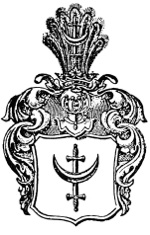TYSZKA
family website
TYSZKA
family website
Translated by Ania Budziak
TYSZKA OF THE TRZASKA ARMS
POLISH ARMORIAL
Kasper S. J. Niesiecki
Enlarged with additions from later authors, manuscripts and other official documents
Edited by Jan Nep. Bobrowicz
Vol. IX
Leipzig, Published by Breitkopf and Haertel 1842
Page 125, 126 and part of page127 in “Herbarz Polski”
TRZASKA ARMS
On an azure (blue) background, an or (yellow) crescent, both of its corners upward; and two, chipped pommels with crosses and hilts, where one of the pommels is in the crescent’s middle and the other underneath it. On the helmet above the crown, there is a peacock’s tail with similar crescent and the pommels; thus the arms were described by Paprocki in Gniazdo [The Nest ] fol. 45 and fol. 1187 {Trans. Note: Gniazdo-a full title is actually Gniazdo Cnoty (The Nest of Virtue)-is a work by Paprocki on Polish armorials} also in his O herbach [On Clan Shields] fol. 265.; Okolski v.3. fol. 240; Klejnoty fol.87{Trans. Note: A work by Dlugosz on Polish heraldry}. This coat of arms is called either Trzaska, or Biala or Lubiewa. It was granted to a knight called Trzaska by the King Boleslaw Chrobry (the Brave) on the following occasion. When an enemy was charging at the king, the knight was shielding the master with his own sword. However, he could not withstand the enemy for long because, when he fiercely struck the nape of the enemy’s neck, his sword broke up to its very hilt. Seeing that, the King swiftly offered his own sword to the knight. The knight, strong by nature and armed with the king’s sword, not only killed that enemy but also butchered to death so many others that their bodies lay around him and, in the end, the King’s sword broke as well. After winning the encounter, the knight returned the sword to the King who, in reward for knight’s courage and his brave heart, bestowed the coat of arms on him to commemorate the event. Paprocki adds that this coat of arms was later known as Lubiewa, for the Lubienski monastery{Trans. Note: I cannot determine the location of Lubienski monastery and do not know whether the name of the town where the monastery was located was Lubien, Lubiewo or Lubiewa}that was funded by three, subsequent generations of the Trzaska arms bearers. To commemorate their support, the monastery uses the Trzaska seal to this day. Paprocki also found other ancestors of the Trzaska clan in the monastery’s documents: Morcha, count from Biala in 1091. Mstygen, count from Biala in 1180. Klemens Szeliga from Janowice, chamberlain of Sieradz in 1436. However, Paprocki also lists him in the Szeliga coat of arms. Some of the members of the family flourish in Lomza land to this day. Stanislaw Trzaska, who in the Pskow Battle of 1582 dismounted his horse and went into the battle on foot (Paprocki O herbach fol. 405). Pawel Trzaska 1680. Jadwiga Trzaskowna {Trans. Note the ending owna indicates that Jadwiga was a daughter of a Trzaska, not a wife of one}a Benedict nun at All Saints { Trans. Note: possibly a name of a church} in Lwow. Mojdylon or Mejdalon Kufolowicz, (Biel. fol.314) or Czusolowicz (Stryjkow. fol 542) took this coat of arms for himself and his descendants during the Hrodelski Sejm when Lithuania was united with the Crown: Adam and Samuel in Warsaw land, Walentyn, Pawel, Maxymilian and Kazimierz in Nursk Land in 1697.
From Krasicki: In the year 1778 Felix Trzaska, Lomza standard-keeper. In the year 1788 Tomasz, Opoczno’s komornik graniczny {Trans. Note: a functionary of the King’s court who, to the best of my knowledge, was responsible for resolving disputes between the nobles regarding property boundaries }
Bearers of these arms
Bialy, Bielski, Blazejowski, Budkiewicz, Chojnacki, Chrzaszczewski, Chrzczonowski, Dluski, Glinka, Goluchowski, Golynski, Jarzyna, Kleczkowski, Kotowski, Kumochowski, Lubiewski, Michalski, Nartowski, Niemirowski, Pancerzynski, Paplinski, Patkowski, Pielasz, Podbielski, Podsedkowski, Ponikiewski, Poplawski, Popowski, Rojecki, Ryczycki, Sczucki, Sieklucki, Slupecki, Sokolowski, Swiejkowski, Szygowski, Trzaska, Trzonkowski, Tyszka, Wedrogowski Wylezynski, Zabielski, Zakrzewski, Zimoszarski and Zorawski.
Kuropatnicki, Malachowski and Wieladek assign this coat of arms to the following additional families: Kotulewicz, Moydylon, Swiecikowski,
In the seventh volume, I spoke about Pancerzynski family, but, back then, I did not know their coat of arms.
Page 175 of the Herbarz Polski
Tyszka of the TRZASKA Arms, in Nursk and Lomza lands, and in the Duchy of Lithuania. Mikolaj Tyszka cannon, parish priest of Warsaw 1622. Balcer, cannon of Luck, who financed Bonifrats in Luck {Trans. Note: an order of St John of God, active in Poland from the 14th century}, an act that was approved by Konstytucyja 1647. fol 39. Wawrzyniec, vice voivode of the Nursk land 1674. Jakob in Minsk land and his son Michal. Stanislaw in Zmudz 1621. Mateusz, canon of Smolen,. Kazimierz in Lomza land 1674. FROM Krasicki: Piotr Tyszka regent of Lomza in 1778 and in 1788 vice starost{Trans Note: a functionary governing a given region in the name of the king}

History of the Tyszka Coat of Arms






